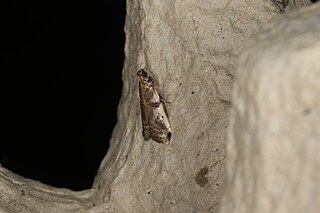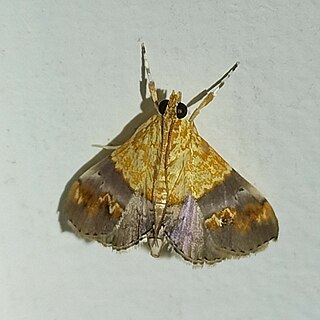
The Pyralidae, commonly called pyralid moths, snout moths or grass moths, are a family of Lepidoptera in the ditrysian superfamily Pyraloidea. In many classifications, the grass moths (Crambidae) are included in the Pyralidae as a subfamily, making the combined group one of the largest families in the Lepidoptera. The latest review by Eugene G. Munroe and Maria Alma Solis retain the Crambidae as a full family of Pyraloidea.

The almond moth or tropical warehouse moth is a small, stored-product pest. Almond moths infest flour, bran, oats, and other grains, as well as dried fruits. It belongs to the family of snout moths (Pyralidae), and more specifically to the tribe Phycitini of the huge snout moth subfamily Phycitinae. This species may be confused with the related Indian mealmoth or the Mediterranean flour moth, which are also common pantry pests in the same subfamily.

Castniidae, or castniid moths, is a small family of moths with fewer than 200 species: The majority are Neotropical with some in Australia and a few in south-east Asia. These are medium-sized to very large moths, usually with drab, cryptically marked forewings and brightly coloured hindwings. They have clubbed antennae and are day flying, and are often mistaken for butterflies. Indeed, some previous classification systems placed this family within the butterflies or skippers. The Neotropical species are commonly known as giant butterfly-moths, the Australian and Asian species as sun moths. The larvae are internal feeders, often on roots of epiphytes or on monocotyledons.

Brachodidae is a family of day-flying moths, commonly known as little bear moths, which contains about 135 species distributed around much of the world. The relationships and status of the presently included genera are not well understood.
Arotrophora arcuatalis, commonly known as banksia boring moth or rarely banksia moth, is a species of Australian tortrid moth best known as a pest of Banksia.

Agrotera is a genus of snout moths in the subfamily Spilomelinae of the family Crambidae. It is the type genus of the tribe Agroterini and currently comprises 28 species distributed in the Afrotropical, Palearctic, Indomalayan and Australasian realm.

Tetracona is a genus of snout moths in the subfamily Spilomelinae of the family Crambidae. The genus was described by Edward Meyrick in 1884 with Aediodes amathealisWalker, 1859 as type species.
Whittenella is a genus of moths of the family Tortricidae containing the sole species Whittenella peltosema.

Cadra is a genus of small moths belonging to the family Pyralidae. The genus Ephestia is closely related to Cadra and might be its senior synonym. Several of these moths are variously assigned to one or the other genus, in particular in non-entomological sources. Cadra and Ephestia belong to the huge snout moth subfamily Phycitinae, and therein to the tribe Phycitini.

The Phycitinae are a subfamily of snout moths. Even though the Pyralidae subfamilies are all quite diverse, Phycitinae stand out even by standards of their family: with over 600 genera considered valid and more than 4000 species placed here at present, they unite up more than three-quarters of living snout moth diversity. Together with the closely related Epipaschiinae, they are apparently the most advanced lineage of snout moths.

Assara seminivale, the kernel grub or macadamia kernel grub, is a species of snout moth in the genus Assara. It was described by Turner in 1904, and is known from Australia. There are also records for Sikkim, Tonkin, Sri Lanka, Sumatra and Borneo, but these need verification.
Cadra acuta is a species of snout moth in the tribe Phycitini. It was described by Marianne Horak in 1994. It is found in the Northern Territory as well as on the Cape York Peninsula (Queensland) in Australia.
Cadra corniculata is a species of snout moth in the tribe Phycitini. It was described by Marianne Horak in 1994. It is found in Western Australia near Broome.

Cadra reniformis is a species of snout moth in the tribe Phycitini. It was described by Marianne Horak in 1994. It is found along the northern coast of Australia from Townsville (Queensland) to Darwin, mainly in monsoon forest.
Cadra perfasciata is a species of snout moth in the tribe Phycitini. It was described by Marianne Horak in 1994. It is found in the southern arid areas of Australia, on both sides of the Nullarbor Plain.
Hyalobathra crenulata is a moth in the family Crambidae. It was described by Hari Sutrisno and Marianne Horak in 2003. It is found in Australia, where it has been recorded from Queensland.

Tetracona amathealis is a species of snout moth in the subfamily Spilomelinae of the family Crambidae. It was described by Francis Walker in 1859 based on material collected at Moreton Bay in Queensland, Australia. It is found in New Guinea and Australia, where it has been recorded in Queensland, northern New South Wales and Western Australia. The species was formerly placed in the genus Agrotera, but in a recent taxonomic revision it was transferred back to the re-instated genus Tetracona, of which it is the type species.

Nistra is a genus of snout moths in the family Crambidae. It is monotypic, being represented by the single species Nistra coelatalis, which was formerly included in the genus Agrotera.
Egon Horak is an Austrian mycologist who has described more than 1000 species of fungi, including many from the Southern Hemisphere, particularly New Zealand and South America. He was an executive editor of the scientific journal Sydowia from 1975 to 1989, and a member of the editorial board afterwards.
Marianne Horak is a Swiss-Australian entomologist who specialises in Australian Lepidoptera, particularly the phycitine and tortricid moths, and is considered one of the worldwide leading experts on the systematics of Tortricidae.











